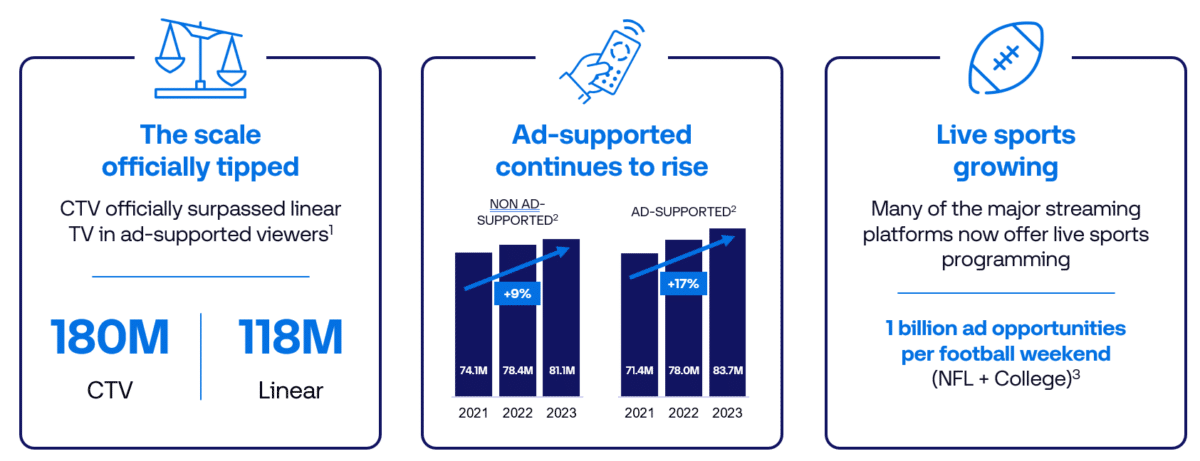From Traditional TV to Streaming: How Advertisers Can Capture Today’s Cord-Cutters
In recent years, the way people consume TV content has changed drastically. The rise of streaming platforms and Connected TV (CTV) has revolutionized how audiences watch their favorite shows and movies. As advertisers, staying relevant and maximizing your marketing strategy means adapting to these changes. Traditional TV advertising, once the gold standard, is now facing a major shift as more viewers cut the cord and move towards streaming platforms. Why is this shift happening? How can traditional/linear TV advertisers embrace streaming platforms? How can reallocating your ad budget help you reach today’s fragmented audience?
Understanding the Cord-Cutting Trend
Television was once the focal point of entertainment, with viewers tethered to their cable subscriptions and linear TV schedules. The world of content consumption is changing at a rapid pace, and the traditional TV model is struggling to keep up. The term “cord-cutting” refers to the trend of viewers canceling their cable subscriptions in favor of more flexible, choice-based streaming services. This transition is having a profound effect on how advertisers should think about reaching consumers.
The Rise of On-Demand Viewing
One of the primary drivers behind cord-cutting is the desire for on-demand viewing. Consumers are no longer content with rigid TV schedules, and they prefer to watch what they want, when they want it. Services like Netflix, Hulu, and Disney+ have risen in popularity because they give audiences the power to choose their content without being constrained by traditional programming. In turn, this shift has significantly decreased the number of viewers tuning in to traditional TV channels, forcing advertisers to reconsider how to target this evolving audience.

Who Are the Cord-Cutters?
Cord-cutting isn’t just limited to young, tech-savvy millennials. Increasingly, older generations are joining the movement, especially as streaming services become easier to access and more affordable than cable packages. With such a significant portion of the population now accessing content via Connected TV devices, advertisers can no longer afford to rely solely on traditional TV ads to reach their target audience.
2023 was the pivotal year when the scales finally tipped – CTV officially surpassed Linear TV ad-supported viewers with 180M CTV and 112M Linear TV. Source: eMarketer 2023
The Fragmentation of Audiences
As cord-cutters migrate to a variety of streaming platforms, the audience landscape has become more fragmented than ever before. Viewers are spread across multiple platforms like Hulu, Amazon Prime Video, Peacock, and YouTube TV, all offering different types of content and viewing experiences. For advertisers, this fragmentation presents both challenges and opportunities. While traditional TV ads could cast a wide net to reach a general audience, Connected TV offers more specific targeting options that allow advertisers to reach niche groups within the vast pool of cord-cutters.

We can evaluate your traditional TV/linear media plan to provide a transition recommendation. Or, we can start from scratch with a detailed analysis of who is visiting your website, and who is converting. We will provide you Connected TV recommendations to reach similar individuals and homes. Our targeting is significantly more advanced compared to Google or Meta’s off-the-shelf digital targeting.
Why Streaming Platforms Are Essential to Your Ad Strategy
Incorporating streaming platforms into your advertising strategy is no longer optional—it’s essential. As cord-cutting continues, streaming platforms are not just a supplementary addition to traditional TV; they have become the primary medium for accessing television content. Here’s why shifting your focus to streaming platforms is crucial for modernizing your ad strategy:
Unmatched Reach and Engagement
Streaming platforms have massive, engaged audiences that are often more attentive than traditional TV viewers. Unlike traditional TV, where viewers might walk away during commercial breaks or channel surf, many streaming platforms feature fewer, non-skippable ads that keep viewers more engaged. Connected TV platforms often limit ad breaks to ensure that ads are watched, which means your message is more likely to be seen in full.
Critically important to understand, an ad impression for CTV or OTT means that a real live human initiated the ad! This impression signifies a specific person, household or device that was targeted and received your ad. This is completely different from Traditional TV or linear TV advertising, where impression counts are (at best) an estimate.
In addition, many platforms, like Hulu and Roku, offer ad-supported options that allow advertisers to reach audiences across different demographics and viewing habits. These viewers have made an active choice to use an ad-supported tier, meaning they understand that advertising is part of their content experience. As a result, these viewers are often more accepting of ads than traditional TV audiences, who might tune out the moment a commercial break begins.
Precision Targeting Capabilities
One of the greatest advantages of streaming platforms is the ability to target viewers with precision that simply isn’t possible with traditional TV. Connected TV allows advertisers to use advanced targeting options similar to those available in digital advertising, such as demographic targeting, behavioral targeting, geo-targeting, remarketing and many other tactics. This means you can deliver ads to a more specific, qualified audience rather than relying on broad demographic assumptions, as is the case with traditional TV.
For example, instead of running a general TV ad during a particular show on a particular network (based on an assumption that X% of those viewers are demographically aligned with your customers) and hoping it reaches a relevant audience, streaming platforms allow you to display your ad to viewers who are actively interested in your product or service. This level of targeting precision not only increases the effectiveness of your campaigns but also helps reduce wasted ad spend by ensuring that your message is being delivered to the right people at the right time.
Advanced Analytics and Measurability
In traditional TV advertising, it can be difficult to measure the true impact of your campaigns. Ratings systems like Nielsen provide a rough estimate of viewership, but they don’t offer much insight into who is watching your ads or how effective they are. Connected TV platforms, on the other hand, offer advanced analytics that allow advertisers to track impressions, viewer engagement, and even conversion rates.
With access to this data, you can make more informed decisions about your campaigns and continually optimize your strategy for better results. Streaming platforms provide advertisers with a clear understanding of how well their ads are performing, including insights into audience behavior, ad completion rates, and even post-ad interactions. This level of transparency simply isn’t available with traditional TV, making Connected TV a far more measurable and actionable medium.
Frequency Controls – No Need To Annoy The Hell Out Of Your Audience
Ad Fatigue is a great way to irritate someone who otherwise might be an ideal customer – but maybe they simply weren’t ready to buy just yet. Viewing the same ad over and over isn’t just a bore. It can perturb your audience for one, but if someone is receiving the same ad repeatedly, it’s a waste of money!
With Connected TV and OTT advertising, which is served programmatically, advanced frequency controls allow us to deliver ad impressions methodically. Impressions can be aggressive at first to build up to an ideal frequency, and then give the viewer some respite and only casual reminder about your brand – or become mellow until it is predicted the viewer is ready to make their decision! Importantly, the impressions that are deliberately not served to someone means we’ve freed up impressions that can be served to other relevant individuals. This makes campaigns significantly more efficient and means we’re not annoying your customers.

We’re serious about not irritating your audience (and being efficient). Levy Online’s frequency controls operate across platforms. Running on Hulu + CBS + NBC + Other CTV Inventory? We can frequency cap across all those inventories with one cap. This prevents over-exposure and crucially frees up those capped impressions to serve to other households. Our frequency controls are way more efficient.
Why Current TV Advertisers Should Shift Ad Dollars to Connected TV
As audiences continue to shift away from traditional TV, so too must your advertising budget. To stay competitive, it’s important to reallocate your ad dollars in a way that maximizes your reach and effectiveness in this new landscape.
The Decline of Traditional TV Ad Effectiveness
Traditional TV has long been seen as a reliable medium for reaching large audiences. However, with more people cutting the cord, the effectiveness of traditional TV ads has diminished. Fewer people are tuning in to cable networks, and those who do are often distracted by other devices, like smartphones and tablets, while watching. This means that the once-guaranteed captive audience of traditional TV is no longer as valuable as it used to be.
Additionally, traditional TV ads are expensive, often requiring large upfront investments without the guarantee of reaching the right audience. As viewership continues to decline, the return on investment for traditional TV ads is also diminishing. Many advertisers are finding that they can achieve better results by reallocating a portion of their TV ad budget to Connected TV platforms, where they can target specific audiences more effectively and at a lower cost.

There’s an extremely important concept called Budget Fluidity. Levy Online doesn’t commit your budget to individual platforms or inventories (like Hulu Ads, ESPN or others). Instead, our budget is allocated dynamically, in real-time, based on a target audience’s predicted value.
Building a Hybrid Strategy
That doesn’t mean traditional TV is obsolete; it still has its place in a well-rounded advertising strategy, particularly for advertisers who want to reach older demographics who may still be loyal to cable. However, the most successful campaigns today often take a hybrid approach, combining traditional TV with Connected TV advertising. This allows advertisers to capture the broad reach of traditional TV while using Connected TV to engage more targeted, younger audiences who have already cut the cord.
By diversifying your ad spend across both traditional and Connected TV platforms, you can ensure that your campaigns reach the widest possible audience, while also taking advantage of the precise targeting and measurement capabilities of streaming platforms. This hybrid strategy can help maximize the impact of your ad dollars and ensure that you’re reaching viewers wherever they choose to consume content.
Budget Reallocation: How Much Should Go to Connected TV?
If you’re currently dedicating the majority of your ad budget to traditional TV, it’s time to rethink how you’re allocating your resources. A good starting point is to gradually shift a portion of your TV budget—between 20-40%—toward Connected TV platforms. This will allow you to experiment with different streaming platforms, test new ad creatives, and measure the results without completely abandoning traditional TV. Again, we have to insist on the importance of Budget Fluidity.
As you start to see the benefits of Connected TV advertising, you can adjust your budget accordingly and continue to shift more of your resources towards this growing medium. Over time, as cord-cutting continues to accelerate, Connected TV is likely to become an even larger part of your overall advertising strategy.
Already On TV? Show Us Your Plan. We’ll Show You Better Value.
Conclusion: Embrace the Future of TV Advertising
The rise of Connected TV and the ongoing trend of cord-cutting have fundamentally changed how advertisers need to approach TV advertising. Traditional TV, while still relevant for certain audiences, is no longer the dominant force it once was. Streaming platforms now offer greater reach, more precise targeting, and advanced analytics that can help advertisers maximize their ad dollars and connect with today’s viewers.
By understanding the cord-cutting trend, embracing streaming platforms, and reallocating your ad spend to reflect the changing landscape, you can position your brand for success in the evolving world of TV advertising. As more and more viewers move away from traditional cable in favor of streaming services, Connected TV offers a powerful opportunity to capture their attention and drive meaningful results for your campaigns.

